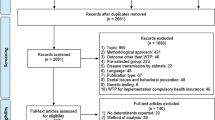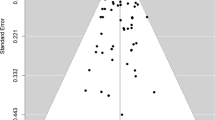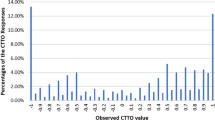Abstract
Health economists use “willingness-to-pay” to assess the prospective value of novel interventions. The technique remains controversial, not least with respect to the formats under which values are elicited. The paper analyses the results of a series of studies of the same intervention valued by the same population, in which different elicitation formats were employed. The findings support the hypothesis that data collected using different formats give rise to different demand curves, from which different inferences about demand elasticity, profitability and consumer surplus will be derived. Judgements as to the relative merits of rival interventions depend crucially upon whichever format has been used to evaluate each intervention.
Similar content being viewed by others
References
Altman, D. G. and J. M. Bland. (2003). “Interaction Revisited: The Difference Between Two Estimates.” British Medical Journal 326, 219.
Bennett, R. and R. Tranter. (1998). “The Dilemma Concerning Choice of Contingent Valuation Willingness-To-Pay Elicitation Format.” Journal of Environmental Planning and Management 41, 253–257.
Birch, S. and C. Donaldson. (2003). “Valuing the Benefits and Costs of Health Care Programmes: Where's the “Extra” in Extra-Welfarism?” Social Science and Medicine 56, 1121–1133.
Birch, S., W. Sohn, A. I. Ismail, J. M. Lepkowski, and R. F. Belli. (2004). “Willingness to Pay for Dentin Regeneration in a Sample of Dentate Adults.” Community Dentistry and Oral Epidemiology 32, 210–216.
Blumenschein, K. and M. Johannesson. (1999). “Use of Contingent Valuation to Place a Monetary Value on Pharmacy Services: An Overview and Review of The Literature.” Clinical Therapeutics 21, 1402–1417.
Blumenschein, K., M. Johannesson, K. K. Yokoyama, and P. R. Freeman. (2001). “Hypothetical Versus Real Willingness to Pay in the Health Care Sector: Results of a Field Experiment.” Journal of Health Economics 20, 441–457.
Brown, T. C., P. A. Champ, R. C. Bishop, and D. W. McCollum. (1996). “Which Response Format Reveals the Truth About Donations to a Public Good?” Land Economics 72, 156–166.
Busch, S., T. Falba, N. Duchovny, M. Jofre-Bonet, S. O'Malley, and J. Sindelar. (2004). “Value to Smokers Improved Cessation Products: Evidence from a Willingness to Pay Survey.” Nicotine and Tobacco Research 6, 631–639.
Carson, R. T., N. E. Flores, and N. F. Meade. (2001). “Contingent Valuation: Controversies and Evidence.” Environmental and Resource Economics 19, 173–210.
Cookson, R. (2003). “Willingness to Pay Methods in Health Care: A Sceptical View.” Health Economics 12, 891–894.
Diener, A., B. O'Brien, and A. Gafni. (1998). “Health Care Contingent Valuation Studies: A Review and Classification of the Literature”. Health Economics 7, 313–326.
Donaldson, C. (1999). “Valuing the Benefits of Publicly-Provided Health Care: Does ‘Ability to Pay' Preclude the Use of ‘Willingness to Pay'?” Social Science and Medicine 49, 551–563.
Donaldson, C., S. Birch and A. Gafni. (2002). “The Distribution Problem in Economic Evaluation: Income and the Valuation of Costs and Consequences of Health Care Programmes.” Health Economics 11, 55–70.
Dong, H., B. Kouyate, J. Cairns, F. Mugisha and R. Sauerborn. (2003a). “Willingness-To-Pay for Community-Based Insurance in Burkina Faso.” Health Economics 12, 849–862.
Dong, H., B. Kouyate, J. Cairns and R. Sauerborn. (2003b). “A Comparison of the Reliability of the Take-It-Or-Leave-It And the Bidding Game Approaches to Estimating Willingness-To-Pay in a Rural Population in West Africa.” Social Science and Medicine 56, 2181–2189.
Foreit, J. R. and K. G. F. Foreit. (2003). “The Reliability and Validity of Willingness to Pay Surveys for Reproductive Health Pricing Decisions in Developing Countries.” Health Policy 63, 37–47.
Frew, E., J. L. Wolstenholme and D. K. Whynes. (2001). “Willingness-To-Pay for Colorectal Cancer Screening.” European Journal of Cancer 37, 1746–1751.
Frew, E. J., V. Hammersley, J. Wolstenholme and D. K. Whynes. (2001). “Collaborating with a Primary Care-Based Research Network.” Journal of Evaluation in Clinical Practice 7, 339–342.
Frew, E. J., D. K. Whynes and J. L. Wolstenholme. (2003). “Eliciting Willingness-To-Pay: Comparing Closed-Ended with Open-Ended and Payment Scale Formats.” Medical Decision Making 23, 150–159.
Frew, E. J., J. L. Wolstenholme and D. K. Whynes. (2004). “Comparing Willingness To Pay: Bidding Game Format vs. Open-Ended and Payment Scale Formats.” Health Policy 68, 289–298.
Frykblom, P. (1997). “Hypothetical Question Modes and Real Willingness to Pay.” Journal of Environmental Economics and Management 34, 275–287.
Hammar, H. and O. Johansson-Stenman. (2004). “The Value of Risk-Free Cigarettes—Do Smokers Underestimate the Risk?” Health Economics 13, 59–71.
Hanley, N., M. Ryan and R. Wright. (2003). “Estimating the Monetary Value of Health Care: Lessons From Environmental Economics.” Health Economics 12, 3–16.
International Agency for Research on Cancer. (2002). “Cancer Incidence, Mortality and Prevalence in the European Union,” EUCAN 1997 estimates, http://www-dep.iarc.fr/eucan/eucan.htm.
Johannesson, M., B. Jonsson and G. Karlsson. (1996). “Outcome measurement in economic evaluation.” Health Economics 5, 279–296.
Johansson, P.-O. (1995). Evaluating Health Risks: An Economic Approach. Cambridge: Cambridge University Press.
Klose, T. (1999). “The Contingent Valuation Method in Health Care.” Health Policy 47, 97–123.
Kristrom, B. (1990). “A Non-Parametric Approach to the Estimation of Welfare Measures in Discrete Response Valuation Studies.” Land Economics 66, 135–139.
Lieberman, D. (1998). “How to Screen for Colon Cancer.” Annual Reviews of Medicine 49, 163–172.
Liljas, B. and K. Blumenschein. (2000). “On Hypothetical Bias and Calibration in Cost-Benefit Studies.” Health Policy 52, 53–70.
Lloyd, A. J. (2003). “Threats to the Estimation of Benefit: Are Preference Elicitation Methods Accurate?” Health Economics 12, 393–402.
Loomis, J., T. Brown, B. Lucero and G. Peterson. (1997). “Evaluating the Validity of the Dichotomous Choice Question Format in Contingent Valuation.” Environmental and Resource Economics 10, 109–123.
Mataria, A., C. Donaldson, S. Luchini and J.-P. Moatti. (2004). “A Stated Preference Approach to Assessing Health Care Quality Improvements in Palestine: From Theoretical Validity to Policy Implications.” Journal of Health Economics 23, 1285–1311.
Mitchell, R. C. and R. T. Carson. (1989). Using Surveys to Value Public Goods: The Contingent Valuation Method. Washington DC: Resources for the Future.
Mulcahy, H. E., M. J. G. Farthing and D. P. O'Donoghue. (1997). “Fortnightly Review: Screening for Asymptomatic Cancer.” British Medical Journal 314, 285–291.
Olsen, J. A. and R. D. Smith. (2001). “Theory Versus Practice: A Review of Willingness to Pay in Health and Health Care.” Health Economics 10, 39–52.
Onwujekwe, O., R. Chima, E. Shu, D. Nwagbo and P. Okonkwo. (2001). “Hypothetical and Actual Willingness to Pay for Insecticide-Treated Nets in Five Nigerian Communities.” Tropical Medicine and International Health 6, 545–553.
Onwujekwe, O., J. Fox-Rushby and K. Hanson. (2004). “Valuing the Benefits of a Health Intervention Using Three Different Approaches to Contingent Valuation: Re-treatment of Mosquito Nets in Nigeria.” Journal of Health Services Research and Policy 9, 67–75.
Onwujekwe, O., K. Hanson and J. Fox-Rushby. (2005). “Do Divergences Between Stated and Actual Willingness to Pay Signify the Existence of Bias in Contingent Valuation Surveys?” Social Science and Medicine 60, 525–536.
Onwujekwe, O., K. Hanson and J. A. Fox-Rushby. (2003). “Who Buys Insecticide-Treated Nets? Implications for Increasing Coverage in Nigeria.” Health Policy and Planning 18, 279–289.
Ready, R. C., J. C. Buzby and D. Hu. (1996). “Differences Between Continuous and Discrete Contingent Valuation Estimates.” Land Economics 72, 397–411.
Ryan, M. (2004). “A Comparison of Stated Preference Methods for Estimating Monetary Values.” Health Economics 13, 291–296.
Ryan, M., D. A. Scott and C. Donaldson. (2004). “Valuing Health Care Using Willingness to Pay: A Comparison of the Payment Card and Dichotomous Choice Methods.” Journal of Health Economics 23, 237–258.
Scholefield, J. H., S. Moss, F. Sufi, C. M. Mangham and J. D. Hardcastle. (2002). “Effect of Faecal Occult Blood Screening on Mortality from Colorectal Cancer: Results From a Randomised Controlled Trial.” Gut 50, 840–844.
Smith, R. D. (2000). “The Discrete-Choice Willingness to Pay Question Format in Health Economics: Should We Adopt Environmental Guidelines?” Medical Decision Making 20, 194–206.
Smith, R. D. (2003). “Construction of the Contingent Valuation Market in Health Care: A Critical Assessment.” Health Economics 12, 609–628.
Towler, B., L. Irwig, P. Glasziou, J. Kewenter, D. Weller and C. Silagy. (1998). “A Systematic Review of the Effects of Screening for Colorectal Cancer Using the Faecal Occult Blood Test, Hemoccult.” British Medical Journal 317, 559–565.
UK Flexible Sigmoidoscopy Screening Trial Investigators. (2002). “Single Flexible Sigmoidoscopy Screening to Prevent Colorectal Cancer: Baseline Findings of a UK Multicentre Randomised Trial.” Lancet 359, 1291–1300.
Whynes, D. K., E. Frew and J. L. Wolstenholme. (2003). “A Comparison of Two Methods for Eliciting Contingent Valuations of Colorectal Cancer Screening.” Journal of Health Economics 22, 555–574.
Whynes, D. K., E. J. Frew, R. Edwards and W. S. Atkin. (2003). “The Costs of Flexible Sigmoidoscopy Screening for Colorectal Cancer in the United Kingdom.” International Journal of Technology Assessment in Health Care 19, 384–395.
Whynes, D. K., J. L. Wolstenholme and E. Frew. (2004). “Evidence of Range Bias in Contingent Valuation Payment Scales.” Health Economics 13, 183–190.
Young, G. P., F. A. Macrae and D. J. B. St John (1996). “Clinical Methods for Early Detection: Basis, use and Evaluation.” In G. P. Young, P. Rozen and B. Levin (eds.) Prevention and Early Detection of Colorectal Cancer. London: WB Saunders Company Ltd.
Author information
Authors and Affiliations
Corresponding author
Additional information
JEL classification: D12, I10
This research was undertaken as a part of the UK Flexible Sigmoidoscopy Screening Trial, funded by Cancer Research UK, the UK Medical Research Council, NHS R&D and Keymed Ltd. None of the funding bodies had any involvement in the writing of this paper or in the decision to submit it for publication.
Rights and permissions
About this article
Cite this article
Whynes, D.K., Frew, E.J. & Wolstenholme, J.L. Willingness-to-Pay and Demand Curves: A Comparison of Results Obtained Using Different Elicitation Formats. Int J Health Care Finance Econ 5, 369–386 (2005). https://doi.org/10.1007/s10754-005-4014-2
Issue Date:
DOI: https://doi.org/10.1007/s10754-005-4014-2




